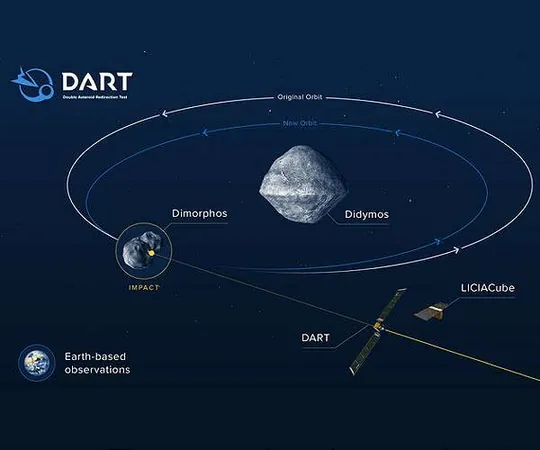
Breakthrough Equation Enhances Tracking of Earthbound Asteroids!
2024-11-26
Author: Nur
Introduction
In an exciting development for astronomy, researchers have unveiled a groundbreaking equation that significantly improves the accuracy of tracking potentially hazardous asteroids. This innovative method builds upon the foundational theories of the great minds of physics, including Sir Isaac Newton and Albert Einstein, to provide a more precise calculation of asteroid orbits.
Research Publication
Published in the Monthly Notices of the Royal Astronomical Society, the research led by Professor Oscar del Barco Novillo from the University of Murcia, Spain, focuses on the gravitational bending of light (GBL) and introduces a new way to calculate the angles at which light bends around massive celestial bodies, such as the Sun. This new equation not only considers the light source and observer positions but also incorporates the influence of static massive objects, offering unprecedented precision in our understanding of the cosmos.
Historical Context
Historically, Newton posited that light could bend due to gravity, and Einstein later developed this concept with his theory of general relativity. However, Professor Novillo’s equation refines these ideas, allowing astronomers to pinpoint the positions of various celestial objects—including asteroids that might threaten Earth—more accurately than ever before.
Significance and Applications
This advancement could revolutionize how we locate distant stars and accurately chart minor solar system objects, such as asteroids, potentially transforming our predictions about their orbits. The implications of this breakthrough are vast, as it will enhance research across multiple fields in astronomy, including celestial mechanics and stellar dynamics.
Broader Implications
But the excitement doesn't stop with asteroids! The newfound precision could also benefit the quest to understand the universe's structure. For example, the equation can be applied to map distant stars like Proxima Centauri, which is about 4.25 light-years from Earth, and its exoplanets. Furthermore, this method is expected to aid in the more detailed mapping of galaxies and their clusters through weak gravitational lensing.
Future Explorations
This improved tracking capability is particularly crucial for missions such as the European Space Agency's Euclid spacecraft. With its mission focused on exploring dark matter and dark energy, Euclid aims to create a detailed cosmic 3D map by observing billions of galaxies over the next six years.
Conclusion
Novillo emphasized the equation's fundamental significance: “Its accuracy in calculating the GBL angle due to a static gravitational mass far surpasses previous approximate equations.” This groundbreaking research could lead to significant advancements in astrometry—the science of measuring the positions and movements of celestial bodies—allowing astronomers to refine their understanding of mass distribution in galaxy clusters and enhancing the predictions for the orbits of near-Earth objects.
Availability of Research
The paper outlining this innovative equation is already available for review in the Monthly Notices of the Royal Astronomical Society. With this step forward in our scientific prowess, the future of asteroid tracking and celestial navigation looks more promising than ever before!


 Brasil (PT)
Brasil (PT)
 Canada (EN)
Canada (EN)
 Chile (ES)
Chile (ES)
 España (ES)
España (ES)
 France (FR)
France (FR)
 Hong Kong (EN)
Hong Kong (EN)
 Italia (IT)
Italia (IT)
 日本 (JA)
日本 (JA)
 Magyarország (HU)
Magyarország (HU)
 Norge (NO)
Norge (NO)
 Polska (PL)
Polska (PL)
 Schweiz (DE)
Schweiz (DE)
 Singapore (EN)
Singapore (EN)
 Sverige (SV)
Sverige (SV)
 Suomi (FI)
Suomi (FI)
 Türkiye (TR)
Türkiye (TR)